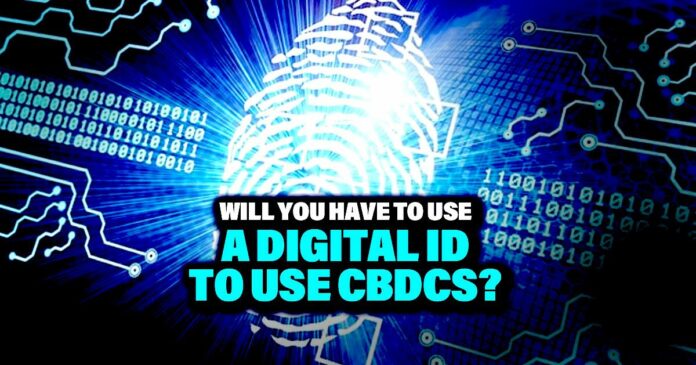To harness the full potential of CBDCs, a robust digital identification (ID) system is essential.
This article delves into the necessity of a digital ID system for using CBDCs. Highlighting examples from around the world and examining the pros and cons associated with these systems.
The Role of Digital ID in CBDCs
A CBDC is a digital form of a country’s national currency issued by its central bank. Unlike cryptocurrencies like Bitcoin, CBDCs are state-backed and operate on a permissioned ledger. Ensuring regulatory compliance and monetary control. So, I think Digital ID systems will be integrated into CBDCs for several reasons:
- Security and Fraud Prevention: A robust digital ID system enhances the security of CBDC transactions. It verifies the identity of the participants. This is possible by reducing the risk of fraudulent activities, such as money laundering or tax evasion.
- Regulatory Compliance: Digital ID systems enable governments and central banks to enforce AML and KYC regulations. This ensures that CBDC transactions remain compliant with national and international laws.
- Privacy and Anonymity: Digital ID systems collect user information. They can be designed to protect user privacy by ensuring that transaction data is pseudonymous. This balances privacy concerns with regulatory requirements.
- Inclusivity: A well-implemented digital ID system can ensure that more people without traditional bank accounts can access and use CBDCs. Fostering financial inclusion.
The big banks will hit you with both a CBDC & digital ID at the same time. Locking in your future as a debt slave. Totally controlled by the state.
Link …. https://t.co/S3VNnsZEAt pic.twitter.com/lPUUd9NeZz— Lynn Phillips (@HappyPawsTreats) October 17, 2023
Examples of Digital ID Systems Worldwide
Here are 4 important examples of how Digital ID Systems are implemented:
- India’s Aadhar: India’s Aadhar system is one of the most extensive and ambitious digital ID projects globally. It assigns a unique 12-digit identification number to every resident, collecting biometric and demographic data. Aadhar facilitates access to various government services, subsidies, and financial transactions. Such as opening bank accounts and receiving welfare payments. However, it has faced privacy concerns and data security issues, prompting legal challenges.
- Estonia’s e-Residency: Estonia’s e-Residency program is a pioneering digital ID initiative. It allows non-residents to access Estonian services and sign documents digitally. This system has attracted businesses and entrepreneurs globally. Pros include ease of doing business, while cons involve security concerns regarding identity theft and fraud.
- China’s Social Credit System: China has implemented a comprehensive social credit system linked to digital IDs. While it can be seen as an example of extensive government control, it has implications for a digital currency. The system assesses individual and corporate creditworthiness based on behavior and transactions. This can limit access to certain services or financial benefits for those with low scores.
- Ecuador’s Sistema de Dinero Electrónico: Ecuador introduced a digital currency linked to a government-issued digital ID. Citizens can access and use this currency through their ID, which aims to foster financial inclusion. However, the system has raised concerns about surveillance and centralization of control.
Be aware of the control you give up with a Central Bank Digital Currency (CBDC)
It's happening in China now.Once you are blacklisted by a social credit system, you can no longer use China's CBDC digital wallet-Alipay or Wechat pay.
Which means you can't order food, book a… pic.twitter.com/JvY31k120p
— Wall Street Silver (@WallStreetSilv) October 17, 2023
Now, let’s take a look at the positive and negative sides of how CBDCs are used with a digital ID.
Pros and Cons of Digital ID Systems
Pros:
- Enhanced Security: Digital ID systems bolster security by verifying the identity of users, reducing fraud and money laundering risks.
- Regulatory Compliance: These systems ensure compliance with AML and KYC regulations, fostering transparency and accountability.
- Inclusivity: Digital IDs can provide access to financial services for marginalized populations, reducing the unbanked or underbanked.
- Efficiency: Transactions become more efficient and less prone to errors due to automated verification.
Cons:
- Privacy Concerns: Collecting personal data raises privacy concerns, with potential misuse and data breaches being significant risks.
- Exclusion: While digital IDs aim for inclusivity, they can inadvertently exclude those without access to technology or official documentation.
- Centralization: These systems are often centralized, granting substantial control to authorities. This can be abused and undermine democratic principles.
- Security Vulnerabilities: Digital IDs are susceptible to hacking, identity theft, and unauthorized access, posing serious risks to individuals’ personal information.
China's SkyNet now has over 850 million facial recognition surveillance cameras —— half of the world total.
In China, CBDC is linked to your digital ID/face.
If you're speeding, SkyNet (cameras) will automatically fine you and debit your bank account via digital Wallet. https://t.co/EILGbg1SE7 pic.twitter.com/24u4L1HYpH
— Songpinganq (@songpinganq) October 14, 2023
Conclusion
Central Bank Digital Currencies have the potential to revolutionize the financial industry. Making transactions faster, cheaper, and more secure. However, to fully realize these benefits, a well-implemented digital ID system is crucial. International examples, such as India’s Aadhar, Estonia’s e-Residency, and China’s Social Credit System, showcase the impact of these systems, with their respective pros and cons.
Digital ID systems must balance the imperative to enhance security and regulatory compliance with the protection of individual privacy and rights. As governments and central banks continue to explore the development of CBDCs, they must prioritize the careful design and implementation of digital ID systems to ensure a secure, inclusive, and efficient transition to digital currencies. Achieving this balance is essential to reap the full benefits of CBDCs while respecting individuals’ privacy and autonomy.
Disclaimer
The information discussed by Altcoin Buzz is not financial advice. This is for educational, entertainment, and informational purposes only. Any information or strategies are thoughts and opinions relevant to the accepted levels of risk tolerance of the writer/reviewers and their risk tolerance may be different than yours. We are not responsible for any losses that you may incur as a result of any investments directly or indirectly related to the information provided. Bitcoin and other cryptocurrencies are high-risk investments so please do your due diligence. Copyright Altcoin Buzz Pte Ltd.





























